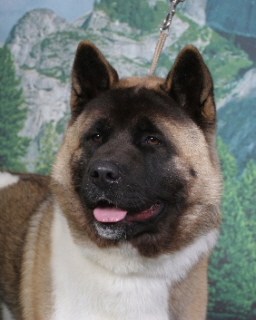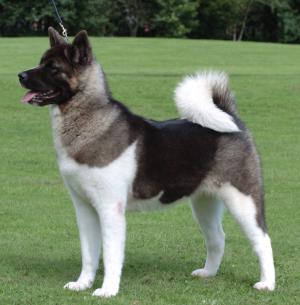Akita




Description
The Akita, also known as the American
Akita, is a member of the working group of dogs. This breed is most
notable for looking a lot like a giant teddy bear with its thick fluffy
coat, stocky legs, and characteristic facial features. In the United
States and Canada the American Akita and the Japanese Akita (also known
as the Akita Inu) are considered to be the same breed, but outside of
these countries they are categorized as different breeds. The Akita stands 25-28 inches at the
shoulders. Females weigh anywhere from 75-85 lbs and males are 75-120
lbs. The Akita Inu come in five colors: Red, Fawn, Sesame, Brindle, and
Pure White. All except white must have whitish hair on the sides of the
muzzle, on the cheeks, the neck, chest, body, and tail. In the U.S. and Canada there is only a single Akita breed registered
by the major kennel clubs. In every other country in the world they are
separated into two breeds: the Akita Inu and the American Akita.
All colors are accepted in the American Akita. The pinto color is not
accepted as an Akita Inu color. In the United States, some breeders
interbreed the original Japanese type with the heavier American type,
which is larger, and allows more colors. Some feel that combining the
two types leads to improved appearance and genetic health by increasing
genetic diversity.
Akitas possess a double-coat, with a dense straight undercoat, and a
thick outercoat. This coat makes the dog waterproof, as well as being
well-equipped for fierce winters. Due to the thickness of their coat,
the breed requires daily grooming, and also an awareness of the dog's
heavy shedding, especially during warm weather.
Temperament
The Akita has a very calm and watchful personality. It is alert, faithful, and protective of its family, and it can bond very strongly with one person. The Akita is a very dominant dog, and it does not interact well with other dogs. For this reason, the Akita does best as an only dog, and should not be off its leash around other dogs. While the Akita will watch over and protect children in the family, younger children and children visiting the home should not interact with the Akita without supervision. These are large and powerful dogs, and they need to be treated with respect.
The Akita lives for an average of 10 to 12 years. Increased health risks associated with the breed include hip dysplasia, hypothyroidism, and various immune diseases.
info courtesy:http://www.petwave.com/Dogs/Dog-Breed-Center


 TT
TT












